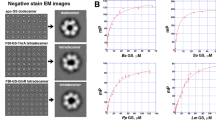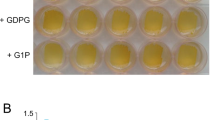Abstract
Escherichia coli cells carrying the gltX351 allele are unable to grow at 42° C (Ts phenotype) due to an altered glutamyl-tRNA synthetase. We found that gltX351 cells display a new phenotype termed Gsd−, i.e. an inability to raise glutamine synthetase activity above low constitutive levels in minimal medium with 6.8 mM glutamine as sole nitrogen source. When 0.5 mM NH +4 or 12 mM glutamate replaced glutamine, the glutamine synthetase activities of gltX351 cells were raised to wildtype levels. Northern experiments showed that the Gsd− phenotype is the result of an impairment in transcription initiation from the Ntr-regulated promoter, glnAp2. Intragenic and extragenic secondary mutations appeared frequently in gltX351 cells, which suppressed their Gsd− but not their TS phenotype. Moreover, in heterozygous gltX +/gltX351 partial diploids, gltX351 was dominant for the Gsd− phenotype and recessive for the Tr phenotype. A slight increase in the glutamine pool and in the intracellular glutamine: 2-oxoglutarate ratio was also observed but this could not account for the Gsd− phenotype of gltX351 cells. In cells carrying gltX351 and a suppressor of the Gsd− phenotype, sup-1, tightly linked to gltX351, the glutamine pool and glutamine: 2-oxoglutarate intracellular ratio were even higher than in the gltX351 single mutant. These results indicate that the gltX351 mutant polypeptide may be the direct cause of the Gsd− phenotype. The possibility that it interacts with one or more components that trigger the Ntr response is discussed.
Similar content being viewed by others
References
Aiba H, Adhya S, DeCrombrugghe B (1981) Evidence for two functional gal promoters in intact Escherichia coli cells. J Biol Chem 256:11905–11910
Avissar YJ, Beale SI (1989) Identification of the enzymatic basis for δ-aminolevulinic acid auxotrophy in a hemA mutant of Escherichia coli. J Bacteriol 171:2919–2924
Backman KC, Chen Y-M, Ueno-Nishio S, Magasanik B (1983) The product of glnL is not essential for regulation of bacterial nitrogen assimilation. J Bacteriol 154:516–519
Bender RA, Janssen KA, Resnik AD, Blumenberg M, Foor F, Magasanik B (1977) Biochemical parameters of glutamine synthetase from Klehsiella aerogenes. J Bacteriol 129:1001–1009
Breton R, Safancon H, Papayannopolous I, Biemann K, Lapointe J (1986) Glutamyl-tRNA synthetase of Escherichia coli. Isolation and primary structure of the gltX gene and homology with other aminoacyl-tRNA synthetases. J Biol Chem 262:10610–10617
Calderón J, Morett E, Mora J (1985) ω-amidase pathway in the degradation of glutamine in Neurospora crassa. J Bacteriol 161:807–809
Cashel M, Rudd KE (1987) The stringent response. In: Neidhardt FC, Ingraham JL, Low KB, Magasanik B, Schaechter M, Umbarger HE (eds) Escherichia coli and Salmonella typhimurium. Cellular and molecular biology. American Society for Microbiol, Washington DC, pp 1410–1438
Castafio I, Bastarrachea F, Covarrubias AA (1988) gltBDF operon of Escherichia coli. J Bacteriol 170:821–827
Chaney AL, Marbach EP (1962) Modified reagents for determination of urea and ammonia. Clin Chem 8:130–132
Cooper AJL, Meister A (1977) The glutamine transaminase-ω-amidase pathway. CRC Crit Rev Biochem 7:281–302
Covarrubias AA, Sánchez-Pescador R, Osorio A, Bolivar F, Bastarrachea F (1980) ColEI hybrid plasmids containing Escherichia coli genes involved in the biosynthesis of glutamate and glutamine. Plasmid 3:150–164
Carcíarrubio A, Lozoya E, Covarrubias AA, Bolivar F (1983) Structural organization of the genes that encode the two glutamate synthase subunits of Escherichia coli K12. Gene 26:165–170
Gendron N, Breton R, Champagne N, Lapointe J (1992) Adenylosuccinate lyase of Bacillus subtilis regulates the activity of the glutamyl-tRNA synthetase. Proc Natl Acad Sci USA 89:5389–5392
Grunberg-Manago M (1987) Regulation of the expression of aminoacyl-tRNA synthetases and translation factors. In: Neidhardt FC, Ingraham JL, Low KB, Magasanik B, Schaechter M, Umbarger HE (eds) Escherichia coli and Salmonella typhimurium. Cellular and molecular biology. American Society for Microbiol, Washington DC, pp 1386–1409
Kern D, Potier S, Boulanger Y, Lapointe J (1979) The monomeric glutamyl-tRNA synthetase of Escherichia coli. Purification and relation between its structural and catalytic properties. J Biol Chem 254:518–524
Körner A, Magee BB, Liska B, Low KB, Adelberg EA, Söll D (1974) Isolation and partial characterization of a temperaturesensitive Escherichia coli mutant with altered glutaminyl-transfer ribonucleic acid synthetase. J Bacteriol 120:154–158
Kustu S, Hirschman J, Burton D, Jelesko J, Meeks JC (1984) Covalent modification of bacterial glutamine synthetase: physiological significance. Mol Gen Genet 197:309–317
Kustu S, Sci K, Keener J (1986) Nitrogen regulation in enteric bacteria. In: Booth IR, Higgins CF (eds) Regulation of gene expression 25 years on. Symposium of the Society for General Microbiology, Cambridge University Press, Cambridge, UK, pp 139–154
Lapointe J, Söll D (1972) Glutamyl transfer ribonucleic acid synthetase of Escherichia coli I. Purification and properties. J Biol Chem 247:4966–4974
Lapointe J, Delcuve G, Duplain L (1975) Derepressed levels of glutamate synthase and glutamine synthetase in Escherichia coli mutants altered in glutamyl-transfer ribonucleic acid synthetase. J Bacteriol 123:843–850
León P, Romero D, Garciarrubio A, Bastarrachea F, Covarrubias AA (1985) Glutamine synthetase-constitutive mutation affecting the glnALG upstream promoter of Escherichia coli. J Bacteriol 164:1032–1038
Li J-M, Brathwaite O, Cosloy SD, Russell CS (1989) 5-aminolevulinic acid synthesis in Escherichia coli. J Bacteriol 171:2547–2552
Lindroth P, Mopper K (1979) High performance liquid chromatographic determination of subpicomole amounts of amino acids by precolumn fluorescence derivatization with o-phtaldialdehyde. Anal Chem 51:1667–1674
Lowry OH, Passonneau JV (1972) A flexible system of enzymatic analysis. Academic Press, New York, pp 78–82
Lowry OH, Rosebrough NJ, Farr AL, Randall RJ (1951) Protein measurement with the Folin phenol reagent. J Biol Chem 193:265–275
Lowry OH, Carter J, Ward JB, Glaser L (1971) The effect of carbon and nitrogen source on the level of metabolic intermediates in Escherichia coli. J Biol Chem 246:6511–6521
Magasanik B (1982) Genetic control of nitrogen assimilation in bacteria. Annu Rev Genet 16:135–168
Meers JL, Tempest DW, Brown CM (1970) Glutamine (amide): 2-oxoglutarate amino transferase oxido-reductase (NADP), an enzyme involved in the synthesis of glutamate by some bacteria. J Gen Microbiol 64:187–194
Messing J, Crea R, Seaburg PH (1981) A system for shotgun DNA sequencing. Nucleic Acids Res 9:309–321
Ninfa AJ, Reitzer LJ, Magasanik B (1987) Initiation of transcription at the bacterial glnAp2 promoter by purified E. coli components is facilitated by enhancers. Cell 50:1039–1046
O'Neil GP, Chen M-W, Söll D (1989) δ-aminolevulinic acid biosynthesis in Escherichia coli and Bacillus subtilis involves formation of glutamyl-tRNA. FEMS Microbiol lett 60:255–260
Osorio AV, Servin-Gonzalez L, Rocha M, Covarrubias AA, Bastarrachea F (1984) cis-dominant glutamine synthetase constitutive mutations of Escherichia coli independent of activation by the glnG and glnF products. Mol Gen Genet 194:114–1123
Pahel G, Zelenetz AD, Tyler B (1978) gltB gene and regulation of nitrogen metabolism by glutamine synthetase in Escherichia coli. J Bacteriol 133:139–148
Powers DM, Ginsburg A (1978) Monomeric structure of glutamyltRNA synthetase in Escherichia coli. Arch Biochem Biophys 191:673–679
Prusiner S (1975) Regulation of glutaminase levels in Escherichia coli. J Bacteriol 123:992–999
Reitzer LJ, Magasanik B (1985) Expression of glnA in Escherichia coli is regulated at tandem promoters. Proc Natl Acad Sci USA 82:1979–1983
Reitzer LJ, Magasanik B (1986) Transcription of glnA in Escherichia coli is stimulated by activator bound to sites far from the promoter. Cell 45:785–792
Reitzer LJ, Magasanik B (1987) Ammonia assimilation and the biosynthesis of glutamine, glutamate, aspartate, asparagine, l-alanine, and D-alanine. In: Neidhardt FC, Ingraham JL, Low KB, Magasanik B, Schaechter M, Umbarger HE (eds) Escherichia coli and Salmonella typhimurium. Cellular and molecular biology. American Society for Microbiol, Washington DC, pp 302–320
Rhee SG, Chock PB, Stadtman ER (1985) Glutamine synthetase from Escherichia coli. Methods Enzymol 113:213–241
Rocha M, Vázquez M, Garciarrubio A, Covarrubias AA (1985) Nucleotide sequence of the glnA-glnL intercistronic region of Escherichia coli. Gene 37:91–99
Rosenfeld SA, Brenchley JE (1980) Regulation of nitrogen utilization in hisT mutants of Salmonella typhimurium. J Bacteriol 143:801–808
Russel RRB, Pittard AJ (1971) Mutants of Escherichia coli unable to make protein at 42° C. J Bacteriol 108:790–798
Safancon H, Lerasseur S, Roy PH, Lapointe J (1983) Cloning of the gene for Escherichia coli glutamyl-tRNA synthetase. Gene 22:175–180
Sales M, Brenchley JE (1982) The regulation of ammonia assimilatory enzymes in Rel+ and Rel− strains of Salmonella typhimurium. Mol Gen Genet 186:263–268
Senior PJ (1975) Regulation of nitrogen metabolism in Escherichia coli and Klebsiella aerogenes: studies with the continuous culture technique. J Bacteriol 123:407–418
Servin-González L, Bastarrachea F (1984) Nitrogen regulation of synthesis of the high-affinity methylammonium transport system of Escherichia coli. J Gen Microbiol 130:3071–3077
Stadtman ER, Chock PB (1978) Interconvertible enzyme cascades in metabolic regulation. Curr Top Cell Regul 13:53–95
Thomas PS (1980) Hybridization of denatured RNA and small DNA fragments transferred to nitrocellulose. Proc Natl Acad Sci USA 77:5201–5205
Author information
Authors and Affiliations
Additional information
Communicated by H. Hennecke
Rights and permissions
About this article
Cite this article
Osorio, A.V., Camarena, L., Salazar, G. et al. Nitrogen regulation in an Escherichia coli strain with a temperature sensitive glutamyl-tRNA synthetase. Molec. Gen. Genet. 239, 400–408 (1993). https://doi.org/10.1007/BF00276938
Received:
Accepted:
Issue Date:
DOI: https://doi.org/10.1007/BF00276938




